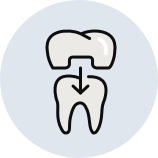No one wants to hear they have a cavity. However, when they’re caught early during your regular dental checkups or dental hygiene appointments, fixing it can prevent further problems.
Fixing a cavity is a common dental procedure that repairs a small hole or “cavity” that has formed in your tooth from decay. The decay is removed and filled with a material to restore tooth function and a natural look.
What Is A Cavity?
Cavities are holes caused by bacteria. The bacteria live in a sticky film called plaque that forms on the teeth. When you eat sugary or starchy foods, the bacteria in plaque use the sugar as energy and produce acid as a byproduct.
The acid erodes or eats away at the enamel (hard outer layer of the tooth), creating a hole or “cavity” in the tooth. If left untreated, cavities can grow larger and deeper to reach the dentin (inner layer of the tooth).
Once this happens, you can be more susceptible to infection and tooth loss. Depending on the amount and severity of tooth decay, it may be visible during an exam or need an x-ray.
You can experience the following symptoms if you have a cavity:
- Tooth sensitivity
- Tooth pain
- Hole in your teeth (sometimes visible)
- Black or white staining on your teeth
Certain factors can increase your risk of developing cavities, such as:
- Poor oral hygiene: If you don’t brush and floss regularly, plaque can build up on your teeth and increase your risk of cavities.
- A diet high in sugar and other carbohydrates: These foods can feed the bacteria in plaque and increase acid production.
- Dry mouth: Saliva helps to neutralize acid and rinse away food particles. A dry mouth can increase your risk for cavities.
- Acid reflux: If you have acid reflux (gastroesophageal reflux disease or GERD), stomach acid can flow back into your mouth and erode your enamel.
- Not enough fluoride: Fluoride helps prevent cavities and may even reverse tooth damage in the early stages. Fluoride is a common ingredient in toothpaste and mouth rinses.
Process for Fixing a Cavity
To fix a cavity, your dentist will first remove the decayed portion of the tooth. Then they will fill the cleaned-out area with a material such as a white filling. White fillings look like your natural teeth and are bonded to the tooth to restore function and prevent further decay.
If a cavity is too large or deep for repair with a filling, your dentist may recommend a crown. Crowns are a type of covering or cap that fits over the remaining portion of the tooth to protect it and restore its function.
Solea Technology
Filling a cavity is typically a painless procedure. However, we understand that some people, especially children, can have anxiety when visiting the dentist, whether it’s about pain, noise from the drill, or needles.
To put dental fears to rest, consider Solea laser technology. Solea technology is a CO2 laser that uses light energy instead of some traditional dental tools.
Solea Laser Technology used to perform dental procedures has many benefits:
- Eliminates discomfort for those who have difficulty sitting still for long periods.
- Eliminates the need for anesthesia for those who have a fear of needles.
- No more bleeding.
- Pain-free dental treatments.
Ways to Prevent Cavities
You can help to keep your teeth healthy and free of cavities by following these tips:
- Brush your teeth twice a day with fluoride toothpaste to remove plaque.
- Floss daily to remove plaque and food particles between your teeth and along the gumline.
- Use mouthwash to kill bacteria and freshen your breath.
- Limit sugary and acidic foods and drinks, which can contribute to tooth decay.
- Drink plenty of water to help wash away food particles and bacteria.
- Eat a healthy, balanced diet that includes foods rich in vitamins and minerals, which can help keep your teeth and gums healthy.
- Have regular dental checkups and cleanings to remove plaque and tartar (a hard, calcified form of plaque) from your teeth.
- Consider using dental sealants—thin coatings applied to the chewing surfaces of the back teeth to protect them from decay.
Pain-Free Solution to Fixing Cavities
Despite good oral hygiene habits, tooth decay can creep up on you. Fixing a cavity early on can help prevent more serious problems and ensure the tooth remains healthy and functional.
Book an appointment with the team at Outdoor Dental for regular exams, teeth cleanings, and a pain-free way to fix your cavities to maintain healthy teeth and gums.













